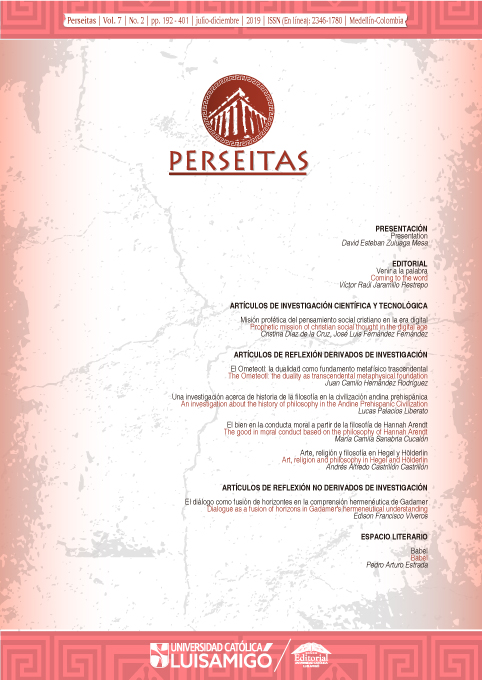Art, religion and philosophy in Hegel and Hölderlin
DOI:
https://doi.org/10.21501/23461780.3294Keywords:
Art, Religion, Philosophy, Hegel, HölderlinAbstract
The purpose of this article is to explain the notions of art, religion and philosophy
exposed by the philosopher Hegel and the writer Friedrich Hölderlin in their
works: Encyclopedia of Philosophical Sciences, Lessons on Aesthetics, and
Hyperion, or the hermit in Greece respectively. This paper intent to contrast
the two stances mentioned above and, to analyze Hegel’s interpretation of art.
Both authors conceive this triad as a manifestation and externalization of the
production and spiritual development of people. Hölderlin gives art validity and
vitality to intercede in the construction of modern society at the religious and
political level, but Hegel believes that philosophy, which exceeds and preserves
art and religion, has priority in modernity as much as possible understanding
and progress of the current moment. The text concludes by indicating the
differences between these two positions.
Downloads
References
Béguin, A. (1994). El alma romántica y el sueño. Colombia: FCE. Primera reimpresión.
Blanchot, M. (2002). El espacio literario. Madrid: Editorial Nacional.
“Hegel y la religión”. (2008). En: Díaz, A., Acosta, M. del R. (ed.) La nostalgia de lo absoluto: pensar a Hegel hoy. Recuperado de https://www.academia.edu/415551/La_nostalgia_de_lo_absoluto_pensar_a_Hegel_hoy
Domínguez, J. (2008). Arte como formelle Bindung en el mundo moderno en la estética de Hegel. En: Estudios de filosofía. No. 37, 201-221.
Dudley, W. (2009). Hegel, Nietzsche, and philosophy. Thinking freedom. Cambridge: Cambridge University Press.
Ginzo Fernández, Ar. (1996). Política, religión y filosofía en G. W. F. Hegel. En: Revista de estudios políticos (Nueva Época). No. 94, 111-145.
Hegel, G.W.F. (2017). Enciclopedia de las ciencias filosóficas. Madrid: Abada.
Hegel, G.W.F. (2011). Lecciones sobre la estética. Madrid: Akal.
Hegel, G.W.F. (2006). Filosofía del arte o estética. Madrid: Abada.
Hölderlin, F. (1989). Hiperión. Versiones previas. Madrid: Hiperión.
Hölderlin, F. (2002). Hiperión o el eremita en Grecia. Madrid: Hiperión.
Hölderlin, F. (1990). Correspondencia completa. Madrid: Hiperión.
Kreuzer, J. (2011). Hölderlin Handbuch. Leben. Werk. Wirkung. Stuttgart Weimar: Verlag J.B Metzler.
Mas, S. (1999). Hölderlin y los griegos. Madrid: La balsa de la Medusa.
Másmela, C. (2018). Hölderlin. La intimidad del medio hespérico. Medellín: Universidad de Antioquia.
Pinkard, T. (2002). Hegel. Una biografía. Madrid: Acento.
Reotzer, H. G. (2012). Historia de la literatura en lengua alemana. Desde los inicios hasta la actualidad. Barcelona: Universidad de Barcelona.
Safranski, R. (2012). El romanticismo. Una odisea del espíritu alemán. Barcelona: Tusquets.
Schiller, J.C.F. (1990). Kallias. Cartas sobre la educación estética del hombre. Barcelona: Anthropos.
Wallerstein, I. (2011). El moderno sistema mundial. La segunda era de la gran expansión de la economía-mundo capitalista, 173-1850. México: Siglo XXI.
Downloads
Published
How to Cite
Issue
Section
License
Copyright (c) 2019 Perseitas

This work is licensed under a Creative Commons Attribution-NonCommercial-NoDerivatives 4.0 International License.
La revista y los textos individuales que en esta se divulgan están protegidos por las leyes de copyright y por los términos y condiciones de la Licencia Creative Commons Atribución-No Comercial-Sin Derivar 4.0 Internacional.
















